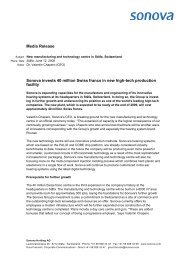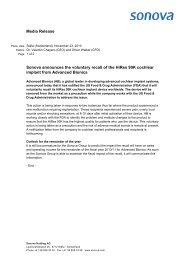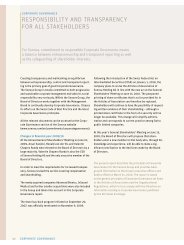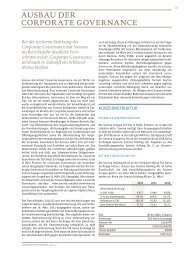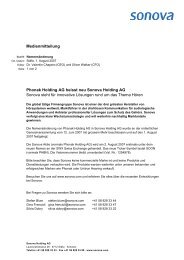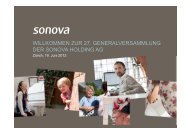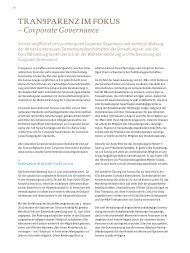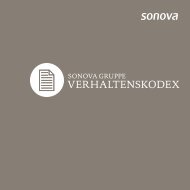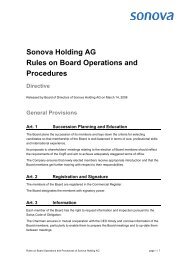Annual Report 2010/11 - Sonova
Annual Report 2010/11 - Sonova
Annual Report 2010/11 - Sonova
You also want an ePaper? Increase the reach of your titles
YUMPU automatically turns print PDFs into web optimized ePapers that Google loves.
98<br />
INveSTMeNTS IN JoINT veNTuReS<br />
Investments in joint ventures are accounted for using the<br />
equity method of accounting. Joint ventures are contractual<br />
arrangements whereby two or more parties undertake an<br />
economic activity that is subject to joint control. Joint<br />
control is the contractually agreed sharing of control over<br />
an economic activity, and exists only when the strategic<br />
financial and operating decisions relating to the activity<br />
require the unanimous consent of the parties sharing<br />
control. under the equity method, the investment in a joint<br />
venture is initially recognized at cost and the carrying<br />
amount is increased or decreased to recognize <strong>Sonova</strong>’s<br />
share of profit or loss of the jointly controlled entity after<br />
the acquisition date. For applying the equity method the<br />
most recent available financial statements of a joint venture<br />
are used, however due to practicability reasons the reporting<br />
dates might vary up to three months from the Group’s<br />
reporting date. The net assets and results from joint ventures<br />
are adjusted, if necessary, to comply with the Group’s<br />
accounting policies.<br />
The Group’s share of equity in joint ventures consolidated<br />
using the equity method is shown in the balance sheet as<br />
“Investments in associates/joint ventures,” and its share<br />
of the results of oper ations for the year is shown in the<br />
income statements as “Share of gain/loss in associates/<br />
joint ventures.”<br />
Joint ventures established during the year are accounted for<br />
as “Investment in associates/joint ventures” from the date<br />
on which joint control over the joint venture is transferred<br />
to the Group and derecognized from that position as of the<br />
date the Group ceases to have joint control.<br />
3.2 Currency translation<br />
The consolidated financial statements are expressed in<br />
Swiss francs (“CHF”), which is the Group’s pres entation<br />
currency. The functional currency of each Group company<br />
is based on the local economic environment to which an<br />
entity is exposed, which is normally the local currency.<br />
Transactions in foreign currencies are accounted for at<br />
the rates prevailing at the dates of the transactions. The<br />
resulting exchange differences are recorded in the local<br />
income statements of the Group companies and included in<br />
net income.<br />
Monetary assets and liabilities of Group companies which<br />
are denominated in foreign currencies are translated using<br />
yearend exchange rates. exchange differences are recorded<br />
as an income or expense. Nonmonetary assets and liabilities<br />
are translated at historical exchange rates. exchange<br />
differences arising on intercompany loans that are considered<br />
part of the net investment in a foreign entity are<br />
recorded in other comprehensive income in equity.<br />
When translating foreign currency financial state ments into<br />
Swiss francs, yearend exchange rates are applied to assets<br />
and liabilities, while average an nual rates are applied to<br />
income statement ac counts (see Note 34). Translation differences<br />
arising from this process are recorded in other<br />
comprehensive income in equity. on disposal of a Group<br />
company, the related cumulative translation adjustment<br />
is transferred from equity and included in the profit or loss<br />
from the disposal in the income statements.<br />
3.3 Accounting and valuation principles<br />
CASH ANd CASH equIvALeNTS<br />
This item includes cash on hand and cash at banks, bank<br />
overdrafts, time deposits and other shortterm highly liquid<br />
investments with original maturities of three months or<br />
less. The cash flow statement summarizes the movements in<br />
cash and cash equivalents. The free cash flow is the net<br />
amount of the cash flow from operating and from investing<br />
activities.




